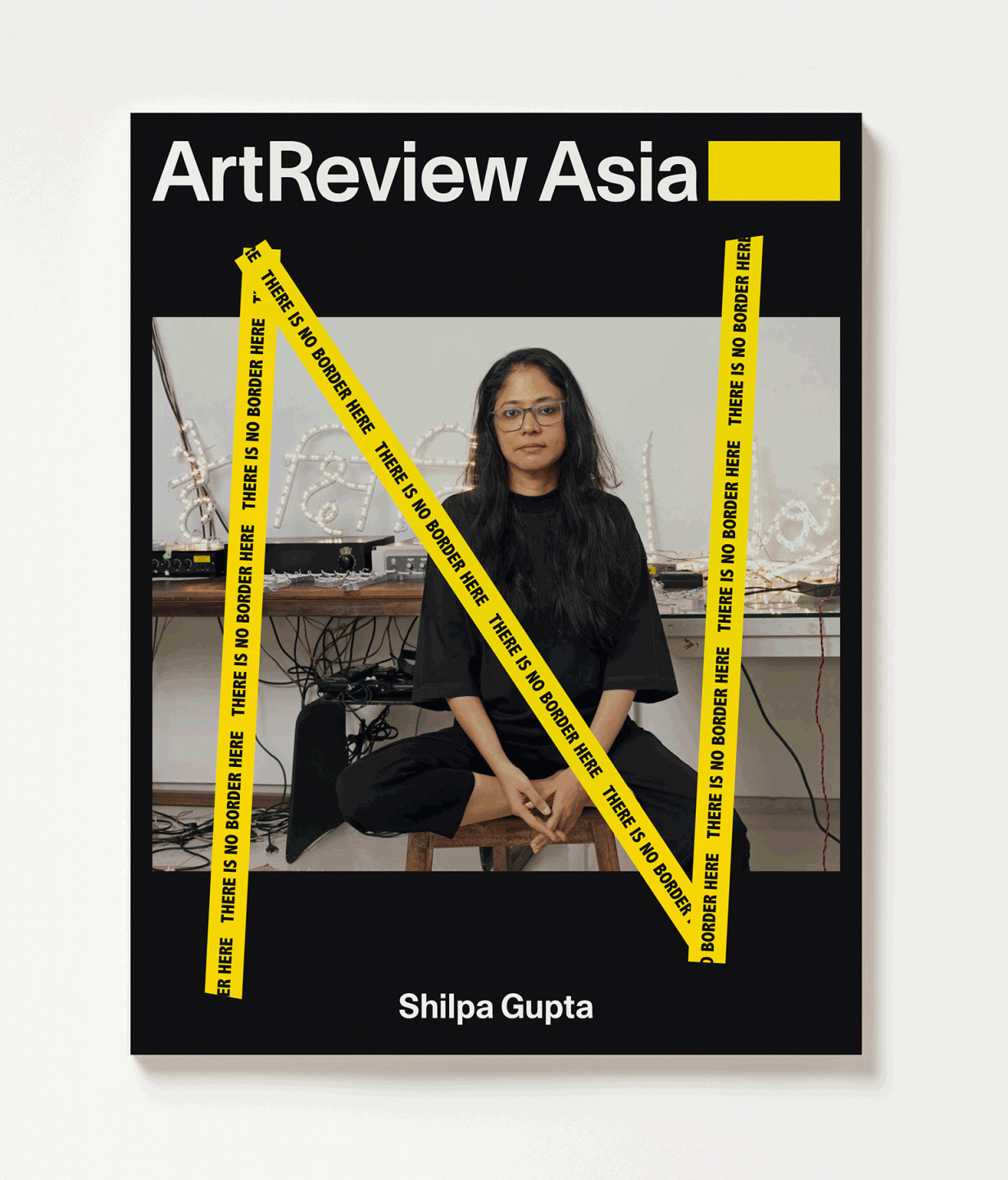
***Subscribe now or get your copy from our new online shop***
This summer, ArtReview Asia thought it might attempt, just a little, to get to grips with how you know where you are. And why that matters. And what it might mean to have all the answers to those types of question.
To kick it all off, the letters that make up Indian artist Shilpa Gupta’s 2006 work There is No Border Here appear in eight variations on the magazine’s cover, introducing a feature by Mark Rappolt that focuses on the ways in which Gupta’s oeuvre frames resistance to division, categorisation, segregation and other forms of violence. State-enforced or otherwise. ‘She reduces what appear to be necessary and eternal systems of control to more contingent and fragile artistic forms,’ writes Rappolt. ‘Borders become lines, lines become drawings, drawings become art, art is a space of fabrication and fabulation.’ Her works turn on ‘the fragile contingency of the relationship between lines on maps and the world as it really is’.
Going from the ground up, Ilaria Maria Sala looks at what it means to create national symbols, particularly when those symbols are drawn from the ‘natural’ environment. In particular she examines how Sri Lanka’s national flower, the nil manel, can be a symbol of purity and enlightenment for some, and a reminder of exclusion, persecution and violence to others. The flower, associated with Buddhist symbolism, was chosen by the Sri Lankan government in Colombo as a national emblem during an acute phase of the civil war, which ended some 20 years later, in 2009, with the Sri Lankan army’s slaughter of tens of thousands of mostly Hindu civilians. ‘What makes this flower truly significant’, she argues, ‘is its religious and political history, which cloaks it in a sombre aura of cruelty.’
Speaking of symbols, Sarah Jilani dives into the visual legacy of the Black Panther Movement to understand why an emotionally resonant visual tradition is essential to the success of any political movement. ‘Political consciousness is partly formed in the symbolic realm,’ writes Jilani. The Black Panthers’ ‘overall stylistic effect projected a community that was organised, empowered, well read and service oriented. It was a total rejection of the dominant images America had imposed on Black people.’ These aesthetics ‘still hold power because they operate from the understanding that you cannot reshape the world unless you first empower the disempowered’.
Meanwhile, the Japanese artist Shimabuku speaks about the origins of and inspirations that lie behind this work, which often focuses on the possibilities of communication between species and cultures. Through text, video and installation, the artist asks unlikely questions: if Japanese snow monkeys were exiled to Texas, would they miss the snow? How is an octopus in Akashi different to one in Santander? ‘In a certain way, the end product of all this is a suggestion that interspecies or geographic boundaries are really not that important. Even as the videos, actions or installations suggest that they are.’
And in the latest ‘Eternal Returns’, in which classic texts that helped shape the art of the past are revisited and updated through the eyes of the present, ArtReview Asia looks back to a 1926 lecture by Rabindranath Tagore in which the Bengali writer-poet-playwright-composer-painter reflects on questions that had long concerned him: what is art, what is tradition, what is Indian? Making early arguments for relativised art histories and multiculturalism along the way.
Also in this issue, Jamie Sutcliffe looks at what became of Masamune Shirow, ‘one of the most influential artists you don’t know’; Max Crosbie-Jones marvels at an ambitious attempt to restore the comprehensively destroyed life work of Indonesian filmmaker Bachtiar Siagian; and Lai Fei argues it’s time to say goodbye to China’s zombie museums.
Plus, exhibition reviews from across the world including Gallery Weekend Beijing, Picasso for Asia at M+ in Hong Kong, Surajate Tongchua in Chiang Mai, Lee Kit in Dublin, Phuong Ngo in Melbourne and Yuji Takeoka in Tokyo; and books by Uketsu, Gurnaik Johal, Benjamin Tausig and more.
***Subscribe now or get your copy from our new online shop***